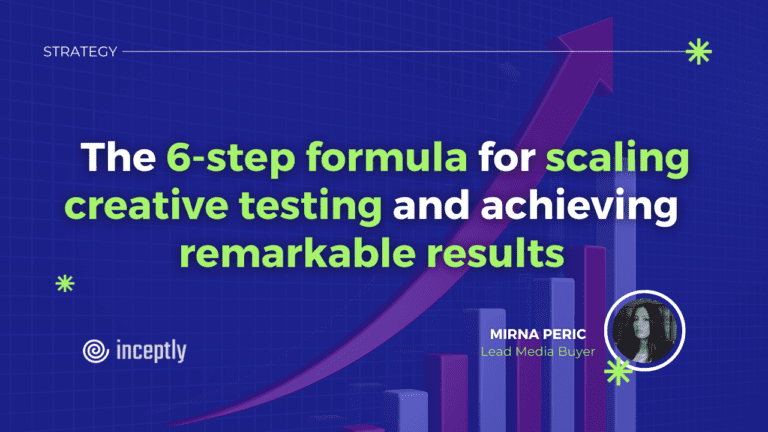
An effective performance creative strategy demands a thorough understanding of what genuinely connects with your audience—and what doesn’t—allowing you to continually refine campaigns for maximum business impact.
However, identifying the key drivers of success can be challenging.
To ensure your brand consistently gains valuable insights and replicates success in a fast-changing market, it’s essential to implement a flexible, standardized testing process.
First and foremost, it’s crucial to emphasize the importance of tailoring your creative ads to each specific platform. If you’ve ever considered using a “one-size-fits-all” strategy for your performance creatives—reconsider.
This isn’t just about meeting the technical requirements for different ads. Every platform has its own unique audience and user behavior. Recognizing these nuances and aligning your ad designs with user expectations is key.
Want to brainstorm with our team on new ways to scale your business with YouTube Ads (and other performance video platforms)?
Join us for a free YouTube ad brainstorming session👇
So, how can you expand your creative testing to gather these insights and enhance your performance? Our experts have crafted a six-step process for scaling creative testing that will guide you toward success.
Step 1: Perform a creative audit to evaluate your current position
The first step in crafting an effective creative testing strategy is conducting a creative audit. This allows you to identify what’s working in your current approach and pinpoint areas for improvement.
But how can you determine if your creative is truly successful?
It might seem simple: analyze the data. Did your campaign achieve the desired results? Did conversions surge? Were click-through rates impressive? Did engagement levels rise?
However, metrics alone don’t tell the full story. There’s a more subjective aspect of success that involves the lasting impression your creative leaves. Well-crafted creative can continue to influence long after the ads stop appearing.
Consider these additional factors and questions beyond the numbers:
1. Concept: A compelling concept ties your work together with a narrative that resonates with your audience on a deeper level.
Does it connect emotionally? Does it evoke genuine feelings?
Is it original? Does it stand out from the competition?
Is it adaptable? Can the concept be extended across various media and audience segments, and remain relevant over time?
2. Messaging: Effective messaging demonstrates a deep understanding of your customers’ needs and desires while remaining concise and actionable.
Is it uniquely positioned? Is it fresh and engaging, or repetitive and stale?
Does it align with your brand voice? Is the messaging recognizable and consistent?
Is there a clear takeaway? Can your audience easily understand the next step without confusion?
3. Look and feel: Your ad’s design should captivate and engage through innovative and inspiring visuals while staying true to your brand identity.
Is it well-executed? Is it visually appealing and balanced? Is there too much or too little happening?
Does it guide the viewer’s attention? Does it maintain engagement and drive the narrative forward?
Is it audience-specific? Is it tailored to resonate with your target audience, or does it feel generic and unfocused?
step without confusion?
Step 2: Use historical data to identify the optimal creative test
Once you’ve completed your creative audit, the next step is to gather and review insights from past creative tests. This will guide your future testing strategy and help you choose the most appropriate tests to achieve your objectives.
A highly effective method we recommend is split testing, also known as A/B testing or single-variable testing. This technique has long been favored by marketers for identifying which ad optimizations produce the best results.
By experimenting with different creative variables in your ads, you can quickly pinpoint the elements that most significantly impact performance. The successful outcomes can then be used to refine your approach and build on your success.
Here are a few examples of basic split tests you can run for ad imagery and messaging:
1. Imagery testing:
lifestyle vs. product features
professional vs. user-generated content
photography vs. illustration
text overlays vs. promotional pricing
GIFs vs. static images
2. Narrative testing:
High-arousal/emotional: surprise + humor vs. happiness + admiration
Rational: value proposition + unique offerings vs. problem + solution approach
Brand positioning: best in class vs. #1 in customer service
Step 3: Develop and align on creative testing questions
Next, create test questions based on what you’re trying to learn and the outcome measures that will determine success.
Think about what you’re trying to accomplish with your campaign and the metrics/KPIs that you can track and measure to prove that your ad creative had an impact on your business’s bottom line.
For example, if your goal is to expand your prospecting pool to drive higher conversions through video, you may want to track specific engagement metrics like watch time, views, likes, shares, or comments. If you’re trying to retarget high-intent audiences who have previously purchased, your KPI might be cost per acquisition (CPA).
As a general best practice, you can always start with one of these creative strategy test questions:
Which story/idea/creative concept drives the best-desired action/goal of the campaign?
Which concept differentiates the most from past campaigns, industry standards, or direct competitors?
What type of ad style is best suited for this concept? (e.g. live-action explainer, UGC, text-animated, etc.)
Step 4: Craft a strong test hypothesis
One way you can ensure your creative test will produce valuable learnings and insights is by centering it around a strong hypothesis.
Your hypothesis should focus on specific assumptions and outcome measures you can clearly prove or disprove through creative tests. In other words, it’s an informed hunch around what position or creative concept will drive results.
So how do you form a succinct, measurable test hypothesis for your ad creative?
Think of it as a proposal statement: a hypothesis is not fact, and should not be argued as right or wrong until it is tested and proven against specific outcome metrics.
Base it on (limited) evidence: Your hypothesis should be informed by as much relevant knowledge and insights as possible. This should include audience data, past campaign research, and analysis of the current challenges you face.
Make sure it can be proved or diproved: a hypothesis pretty much says, “I think by making X change, it will cause Y effect.” So, based on your results, you should be able to say “this is true” or “this is false.”
Your hypothesis can be used as a starting point for deeper campaign exploration and investigation. You should put it together and agree on it before you take any further tactical measures because it needs to guide the wireframe or design of your creative test. It should ultimately help you hone in on what elements to change, how to change them, and which to leave alone.
Step 5: Build a holistic creative testing roadmap
The next step is to design tests and creative elements based on your hypothesis and what you want to learn. Always keep mobile best practices front of mind and make sure each asset:
Highlights the expression of your creative variable early on
Is clearly differentiated from the others you’re experimenting with
Doesn’t have additional variables that might contribute to differences in results (e.g. is your branding consistent across assets?)
When running multiple creative tests in succession, you should have a plan for how they link together and influence one another to ensure that your learnings are always relevant and actionable.
Step 6: Complete the test and share your learnings
Analyze the results based on the outcome measure you identified in your initial hypothesis to determine which asset(s) performed best against that metric—and if the test confirmed your hypothesis.
Look at secondary metrics for additional learnings. For example, did one asset perform better against a specific audience? The more you can understand the “why” behind the success or failure of an asset, the better equipped you are to decide how to adapt it.
To strategically and creatively determine the next best implementation of your learnings, consider these questions:
Does a runner-up still show a strong performance? Can you leverage it to build out the rest of your campaign?
If multiple assets are high performers, which asset or direction feels the most creatively fertile?
Have these learnings uncovered another knowledge gap and new opportunity to betatype through ongoing, intentional creative experimentation?
Remember: When it comes to your creative testing strategy and driving growth, always experiment with fresh, innovative ideas to find out what truly motivates your audience and earns the conversion. You should be constantly running A/B tests, analyzing campaign results, and iterating on the takeaways to drive tangible results that boost business impact.
Creative testing bonus tips:
Think beyond the individual campaign level – To truly amplify the impact of your creative performance, it’s important to scale tests across campaigns and build out a process to draw insights that apply to multiple channels and ad types.
Even winning ads can’t run forever – For your ad creative to reach its full potential, you need a constant flow of new information. You should periodically switch out campaigns with fresh creative and start the testing process all over again.
Move fast and fail forward – Creative risk-taking is part of the joy of performance creative, so don’t be afraid to take a certain amount of risks and experiment with bending your brand rules. Failure is acceptable as long as you bounce back and move forward with a continuous testing mindset.
Want to brainstorm with our team on new ways to scale your business with YouTube Ads (and other performance video platforms)?
Join us for a free YouTube ad brainstorming session👇
Want more content like this?
Don’t miss out on the latest news and updates from the world of Direct Response advertising! Subscribe to our newsletter today 👇

Mirna Peric, Lead Media Buyer
Mirna is a top-notch Media Buyer with years of experience and millions of dollars in revenue-generating ad spend to prove it. Her insatiable curiosity combined with a strategic mindset helps her stay ahead of the game when scaling our clients' offers.
Like this post? Let's continue the conversation!
Get in touch with us by shooting us a quick email or tagging us on LinkedIn or Instagram, and sharing your thoughts. Your feedback helps us keep our blog relevant and interesting.
Get Our Newsletter
Need Help?
Get in touch with us for an insightful evaluation of your ads + actionable tips to help amp up your direct response revenue



